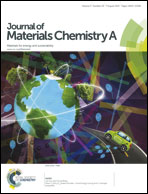Improved performance by morphology control via fullerenes in PBDT-TBT-alkoBT based organic solar cells†
Abstract
In this work, we report improved performance by controlling morphology using different fullerene derivatives in poly{2-octyldodecyloxy-benzo[1,2-b;3,4-b]dithiophene-alt-5,6-bis(dodecyloxy)-4,7-di(thieno[3,2-b]thiophen-2-yl)-benzo[c][1,2,5]thiadiazole} (PBDT-TBT-alkoBT) based organic solar cells. PC60BM and PC70BM fullerenes were used to investigate the characteristic changes in morphology and device performance. Fullerenes affect device efficiency by changing the active layer morphology. PC70BM with broader absorption than PC60BM resulted in reduced device performance which was elucidated by the intermixed granular morphology separating each larger grain in the PC70BM/polymer composite layer which created a higher density of traps. However after adding additive 1,8-diiodooctane (DIO), a fibrous morphology was observed due to the reduced solubility of the polymer and increased solubility of PC70BM in chloroform. The fibrous morphology improved charge transport leading to an increase in overall device performance. Atomic force microscopy (AFM), photo-induced charge extraction by linearly increasing voltage (photo-CELIV), and Kelvin probe force microscopy (KPFM) were used to investigate the nanoscale morphology of the active layer with different fullerene derivatives. For the PC60BM based active layer, AFM images revealed a dense fibrous morphology and more distinct fibrous morphology was observed by adding DIO. The PC70BM based active layer only exhibited an intermixed granular morphology instead of a fibrous morphology observed in the PC60BM based active layer. However, addition of DIO into the PC70BM based active layer led to fibrous morphology. When additive DIO was not used, a wider distribution of surface potential was observed for PC70BM than the PC60BM based active layer by KPFM measurements, indicating that polymer and fullerene domains are separated. When DIO was used, a narrower distribution of surface potential for both PC70BM and PC60BM based active layers was observed. Photo-CELIV experiments showed larger extracted charge carrier density and mobility in the PC70BM/DIO film.


 Please wait while we load your content...
Please wait while we load your content...